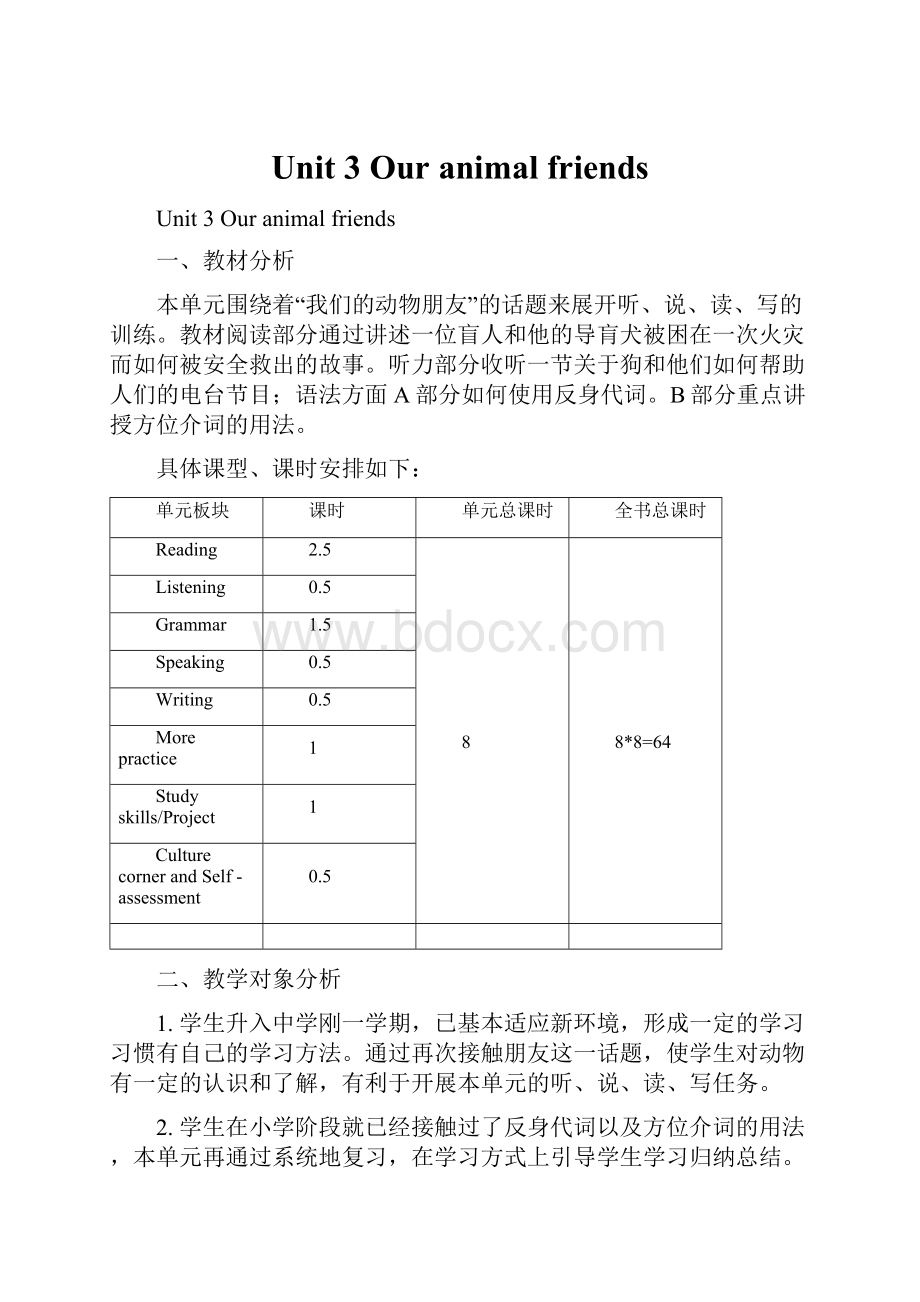Unit 3 Our animal friends.docx
《Unit 3 Our animal friends.docx》由会员分享,可在线阅读,更多相关《Unit 3 Our animal friends.docx(24页珍藏版)》请在冰豆网上搜索。

Unit3Ouranimalfriends
Unit3Ouranimalfriends
一、教材分析
本单元围绕着“我们的动物朋友”的话题来展开听、说、读、写的训练。
教材阅读部分通过讲述一位盲人和他的导肓犬被困在一次火灾而如何被安全救出的故事。
听力部分收听一节关于狗和他们如何帮助人们的电台节目;语法方面A部分如何使用反身代词。
B部分重点讲授方位介词的用法。
具体课型、课时安排如下:
单元板块
课时
单元总课时
全书总课时
Reading
2.5
8
8*8=64
Listening
0.5
Grammar
1.5
Speaking
0.5
Writing
0.5
Morepractice
1
Studyskills/Project
1
CulturecornerandSelf-assessment
0.5
二、教学对象分析
1.学生升入中学刚一学期,已基本适应新环境,形成一定的学习习惯有自己的学习方法。
通过再次接触朋友这一话题,使学生对动物有一定的认识和了解,有利于开展本单元的听、说、读、写任务。
2.学生在小学阶段就已经接触过了反身代词以及方位介词的用法,本单元再通过系统地复习,在学习方式上引导学生学习归纳总结。
三、单元教学目标
1.认知目标:
学习水平
学习内容
学习水平的描述
语音
1.能流利地朗读课文及与课文水平相当的短文,语音、语调、句子重音和停顿基本正确。
2.音标/bl/,/br/;/fl/;/fr/,/gl/,/gr/,/kl/and/kr/的拼读规则
词汇
1.重点词汇
Blind,radio,programme,helful,,mean,,allow,pet,anywhere,apologize,lead,bark,wake,towel,bottom,finally,airport,appear,act,climb,dark,nothing.
词组:
2.拓展词汇
rescue;recetionist
3.专有名词:
Billy,Brown,Charlie,Dancer,Jane,Jimmy,Kevin,Smith,Suzy,White,Winnie
4.短语:
arriveat;byoneself,leadsbto;fallasleep,wakeup,getdown,fireengine
句型
Usefulsentences:
1.“Goodevening,sir”2.Youarewelcometostay,butIamsorrythat….3.Ican’tgoanywherebymyself.4.Hesoonfallasleep5WithCharlie’shelp,….6.ThenhegotdownonthefloornexttoCharlieandwaited8.Afiremanarrivedandgothimoutofthebuilding?
9.Ithink…areveryhelpfulanimals.Theyhelpus…10.Without…,wecannot…11.Weget…from…
语法
1.Learnhowtosaythe/bl/,/br/;/fl/;/fr/,/gl/,/gr/,/kl/and/kr/sounds.
2.Learnhowtouseprepositionofposition.
读(reading)
1.Readanarticleaboutablindmanandhisguidedog.
听(listening)
1.Listenforspecificinformationaboutsomedogsandwhattheydotohelppeople.
说(speaking)
Talkaboutahelpfulstory.
写(writing)
Completearescuestory.
2.思想情感目标:
1)通过谈论“动物”的相关话题,帮助学生对动物有一个新的认识。
2)结合课文的内容,引导学生对动物形成正确的认识,从而做到保护动物的目的。
3.能力发展目标:
1)能够在听、说、读、写等语言综合实践活动中运用本单元的重点词汇、句型与语法。
2)在学习中提高交流和传递信息的能力,在写作中正确运用连词使文章更连贯和流畅。
3)通过指导学生在模拟交际中运用所学的知识,培养学生探究学习、合作学习、自主学习的能力。
四、单元教学重点
1.学生熟练掌握重点词语,词组及句型。
2.指导学生利用所学句型正确表达思想、进行交际活动。
3.指导学生归纳、反身代词以及方位介词的用法,并在实践运用中熟练运用。
4.指导学生如何完成一个解救故事,巩固描述过去发生的一件事情的基本方法。
五、单元教学难点
1.如何将故事补充完整。
2.反身代词的归纳整理及运用。
3.方位介词的归纳整理及运用。
六、教学策略
1.引导学生积极主动的通过预习完成可以自己学会的部分,课堂学习完成学习的重难点,通过复习及归纳总结完善单元的学习。
2.在教学中以旧带新,引导学生用正确的句子表达思想。
3.适当补充与课文话题相关的内容,拓展学生的阅读视野。
七、学习策略
1.初步接触略读(skimming)和找读(scanning)这两种阅读策略。
2.学会在阅读过程中通过上下文来猜测生词含义的方法。
3.关注反身代词以及方位介词的应用,以便准确记录相关信息。
八、媒体的选择与设计
1.充分利用和发挥基本的教学媒体,如录音机,教师的bodylanguage、板书的作用。
2.适时、合理地使用多媒体,增大课堂的容量,更好地辅助教学。
九、各课时教学内容安排建议
课时
教学内容及课型
教学目标及简单教学环节设计
第1课时
ReadingA
Ablindmanandhis“eyes”inafire
新授课
一、定位:
input-based,训练各种听与说的语言微技能,并给予阅读学习策略的指导,读为主。
二、教学设计:
Step1Warmingup
1.AskafewSsthefollowingquestionsaboutanimalordogs.
Q1:
Doyoulikepets?
Whatanimaldoyoulikebest?
Q2:
Doyouthinkdogisourfriend?
Q3:
Doyouthinkdogcanhelpus?
Howdodogshelpus?
Step2Leadingin
1.Whatdoyouthinkadogcandowhenafirehappens?
2.AskSstoMatchthethekinksofdogsintheboxwiththepictures(APage30Thenchecttheanswers.
Step3:
Pre-reading
1)AskSstolookatthephotosandthetitleofthestoryonPage30.thenanswerthequestionsbelow.
a.Whatdoyouthinktheword“eyes”meansinthestory?
b.Whatisthestoryprobablyabout?
GetsstofinishBonpage30andchecktheanswers.
2)Vocabularypresentation:
GetSstolearnsomenewwordsbyshowingsomepictures.(Blind,radio,programme,helful,,mean,,allow,pet,anywhere,apologize,lead,bark,wake,towel,bottom,finally,
3)Cocabularyexercise:
GetSstofinishexerciseC1andC2onpage32toconsolidatethenewwords.
Step4:
While-reading
1.Firstreading
Getsstolistentothetapeandreadfasttoanswer:
a.Whathappenedwhilehewasasleep?
b.f.Weretheysavedatlast?
2.Secondreading
AskSstoreadthetextcarefullyagainandanswerthequestionsbelowandchecttheanswers:
a.HowdidJohnfeel?
Whichwordsinfer(暗示)thatJohnwasangry?
c.HowdidJohnknowtherewasafire?
d.WhatdidJohndotosavehimself?
d.Didthefiremanmeanto(打算)takeCharlie?
Why?
e.WhatdidJohnexplaintothefireman?
Step5Postreading
Groupwork:
:
AskSstofinishexerciseD1andD3onpage33ingroupsandthensharetheiropinionsinclass.
Step6:
Languagepoints
1)keypoints:
a)arriveat/in;(拓展:
reach;getto)
b)allowv.允许;allowsbtodosth允许某人做某事
Eg.老师不允许我们抽烟。
Theteachersdon’t______us________.
c)dosthbyoneself(拓展:
dosthonone’sown)
d)apologizetosb(拓展:
makeanapologytosb:
向某人道歉)
e)lead-led-ledv.带领leadsbtosomewhere带领某人到某地
Eg.他带领我们去到了那个公园。
He______us_____thepark.
f)fallasleep(拓展:
gotobed,sleep)
g)getdown;(拓展:
getup,geton,getoff)
h)both
Step7:
Consolidation
Dosomerelatedexerciseofprepositions,wordsandtranslations.
Step8Homework
1)Gooverwhatyou’velearnedtoday.
第2课时
listening
Topdogs
一、定位:
1.input-based,训练各种听与说的语言微技能,并给予听的学习策略的指导。
Objectives:
1.TeachtheSshowtolistenforspecificinformationabouttopdogs.
2.TeachtheSshowtotakenoteswhilelisteningtotheradioprogrammeabouttopdogs.
二、教学环节设计:
Step1Pre-listening
1.TellSsthattheyaregoingtodosomelisteningexercises.AsksomeoftheSswhattheywilldobeforelistening.
2.LearnthestudytipswithSsbyaskingSstoreadthetipsontheirbookcarefully.(Payattentiontothekeywordswhenlistening.
3.AskSstoreadthetableonpage34carefullyandpredictwhatkindofinformationtheycouldfillintheblanks.Sscandiscussingroupsandwritedowntheiranswerswithpencils.
4.AskSswhattheymustpayattentiontowhentheywrite.Eg:
theirspelling,thefirstletteroftheword,howtowriteanumberetc.
Step2While-listening
1.PlaytherecordingforSstolistenandfillintheblankswiththenamesofthespeakersfromthebox.
2.PlaytherecordingagainforSstolistenandaskthemtochecktheirspelling.
3.Checktheanswersandseehowwelltheydidintheprediction.
Step3Post-listening
a)GiveSssometimeandgetthemtosummarizetheskillsofcompletingatableofinformationandfinishtherelatedlisteningexerciseofinBookB.
b)Groupdiscussion:
chooseoneoftheanimalsbelowandtalkabouthowithelpspeopleusingthesentencestructures:
cow;elephant,horse,sheep
Ithink…areveryhelpfulanimals.Theyhelpus…
Without…,wecannot…
Weget…from…
Step4:
Summary:
askthesstoconcludewhatwe’velearnedtoday.
Step5Homework
FinishStudentsTimesofUnit3listeningexercise.
第4课时
Language
A.Reflexivepronouns
BPrepositionofposition
一、定位:
input-based,训练各种读与说的语言微技在语言知识中的运用
二、教学环节设计:
Step1Revision
a.WehavelearntalotofthingsinreadingA,andletmeseehowwellyouknowaboutthem.
GetSstofindoutthepersonalpronounsinthefollowingpassage.JohnF.DancerwalkedintotheDragon’sHeadHotelwithhisfriendCharlie.Theywenttothereceptiondesk.Johnsaid,“Hi,I’mJohnDancer.IbookedaroomlastSunday.”Theclerksaid,”Yes,sir,butwedon’tallowpetsinthishotel.”
Personalpronouns
第一人称单数
第二人称单数
第三人称单数
第一人称复数
第三人称复数
Fubjectform
I
you
he,she,it
we
they
Objectform
me
you
him,her,it
us
them
Thesubjectisthedoerofanactionandisputinfrontoftheverb.
Theobjectisthenounuponwhichanactionisdone.Itisputaftertheverb.
Step2LanguageA---Reflexivepronouns
1.Weuseareflexivepronounastheobjecttoreferbacktothesubjectofasentence.Writedownsomeexamplesontheblackboard:
a.Heblameshimselfforthemistake.
b.Shemadeherselfacupoftea.
c.Weshouldnotthinkonlyofourselves.
2.Wecanalsouseareflexivepronountoemphasizethatsomeonedoessomethingwithouthelp.Writedownsomeexamplesontheblackboard:
a.Hedidthehomeworkhimself.
b.Wecancleanthekitchenourselves.
3.Writedownthereflexivepronounslikethis:
Reflexivepronouns
人称
第一人称
第二人称
第三人称
单数
myself
yourself
Himself/
herself/
itself
复数
ourselves
yourselves
themselves
4.AskSstoreadthesentencesonP7andworkouttherules.
5.GuidetheSstoconcludetheusageoftheReflexivepronouns
(1)反身代词勇于名词或代词之后或句末,作同位语,表示强调。
Imyselfdidit.=Ididitmyself.
(2)反身代词在句中可用作动词宾语、介词宾语。
Weenjoyedourselvesverymuchlastnight.
Theycantakecareofthemselves.
(3)反身代词在句中可用作表语。
Thatpoorboywasmyself.
注意:
反身代词本身不能单独做主语。
(误)Myselfdrovethecar.(正)Imyselfdrovethecar.
反身代词的固定习语
•Helponeselfto随便吃
•Enjoyonself过得愉快
•Teachoneself自学
•Lookafteroneself照顾自己
•Byoneself单独,独自
•Foroneself为自己
6.GetSstofinishtheexerciseonP36andchecktheanswers.
Step3LanguageB—prepositionsofpostion
1.Weuseprepositionsofpositiontotalkaboutwheresomebodyorsomethingis.Askthemtogivesomeexamples.
Whereisthemouse?
Itisinabowl.;Itisonashelf.
Itisunderabasket.Itisnextto/besideanapple.
ItisinfrontofaTV.Itisbehindavase.
Itisbetweentwobook.Itisaboveacat.
2.GetSstoremembertherules:
3.Exercise:
1)Jasonisdescribinghisbedroom.Helphimcompletehishescriptionwiththecorrectprepositions.(finishexerciseonpage37)checkthequestions.
Step4:
Consolidation:
GetSstofinishsomerelatedexercisesinBookB.
Step5.Summary
askthesstoconcludewhatwe’velearnedtoday.
Step6:
Homework
a.选择题:
()1----Excuseme!
Isthispen_______?
---No.It’s________._______penishere.
A.yours;my;MineB..mine;yours;My
C.yours;mine;MyD.mine;your;My
()2----Whotaught______historylastyear?
----Nobody!
Helearnedit________.
A.her;himselfB.him;himselfC.him;herselfD.him;him
()3----Pleasepassmethebooks.---Which_______are______?
A.one;yourB.one;yoursC.o